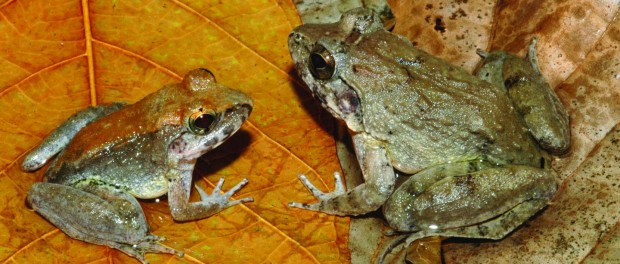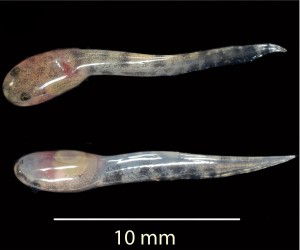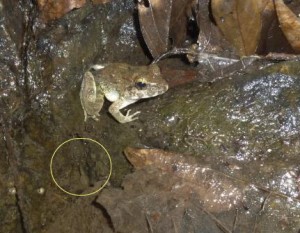A frog that gives birth
 The L. larvaepartus frog (male, left, and female) from the island of Sulawesi in Indonesia. It is the only frog known that gives birth to tadpoles rather than laying spawn. Credit: Jim McGuire photos.
The L. larvaepartus frog (male, left, and female) from the island of Sulawesi in Indonesia. It is the only frog known that gives birth to tadpoles rather than laying spawn. Credit: Jim McGuire photos.
Most frogs lay eggs (frogspawn) in water that grow into tadpoles, froglets and then grown-up frogs. Now scientists have found a frog in the rainforests of Sulawesi Island, part of Indonesia, that gives birth to tadpoles!

Two tadpoles, each about 10 millimeters long, shortly after birth. The newly described species Limnonectes larvaepartus is the only species of frog known to give birth to live tadpoles. Credit: Jim McGuire, UC Berkeley
Jim McGuire, a professor at the University of California, Berkeley in the USA was in the rainforest and found a female frog giving birth to tadpoles. what he saw confirms what others had suspected but never seen happening.
The frog, newly named Limnonectes larvaepartus (L. larvaepartus for short), was discovered a few decades ago by Indonesian researcher Djoko Iskandar, who works with Professor McGuire.
Most male frogs fertilize eggs after the female lays them. About a dozen species have evolved ways to fertilize eggs inside the female’s body. Some of these deposit their fertilized eggs under rocks in streams but others give birth to froglets (miniature replicas of the adults).
There are many other bizarre reproductive variations. Some frogs carry eggs in pouches on their back, brood tadpoles in their vocal sac or mouth, or transport tadpoles in pits on their back. Two sorts of frog, both of which are now extinct, were famous for swallowing their fertilized eggs, brooding them in their stomach, and giving birth out of their mouths to froglets.
L. larvaepartus seems to prefer to give birth to tadpoles in small pools or seeps located away from streams, possibly to avoid bigger frogs hanging out around the stream. The males may also guard the tadpoles.

A male of the newly described species of fanged frog, Limnonectes larvaepartus, sits next to a pool containing tadpoles (yellow circle), and may be guarding them, a typical male behavior in some frog species. Credit: Jim McGuire, UC Berkeley






Leave a comment